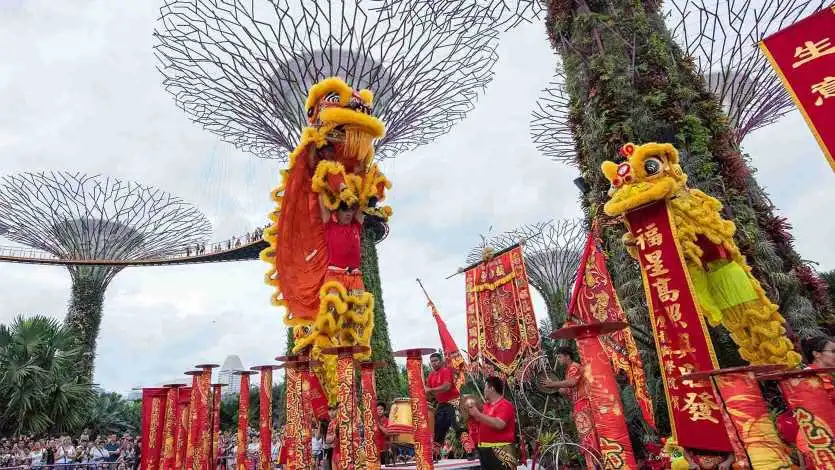The Chinese diaspora across the world celebrates Chinese New Year, also called the Spring Festival or Lunar New Year, as a significant event. Given that most Singaporeans are of Chinese descent, this celebration has particular meaning there. In addition to commemorating the start of the lunar new year, the festivities showcase the diverse range of Chinese customs and culture that are interwoven with New Year Celebration In Singapore.
Do Singapore Celebrate Chinese New Year 2025?
Read Also: 10 Romantic Places in Singapore To Visit With Your Partner In 2023
2025 Chinese New Year
Do Singapore Celebrate Chinese New Year? In 2024, the New Year Celebration In Singapore will take place from Saturday, February 10 to Monday, February 12. Notably, February 12, 2024, will be a public holiday, giving everyone an opportunity to enjoy the festivities to the fullest! The next Lunar New Year, which is known as the Year of the Wood Dragon, is linked to qualities like vigor, wealth, and the pursuit of lofty objectives. It is said that those born in the Year of the Dragon exhibit bravery, intellect, and tenacity.
Singapore's Chinese New Year history
Early Migration and Roots
The origins of Singapore's Chinese New Year may be found in the early waves of Chinese immigration to the area. A vast collection of centuries-old customs, rituals, and beliefs were introduced by Chinese immigrants. As the Chinese population expanded and blended with Singapore's cosmopolitan environment, these customs—which have their roots in Chinese mythology and folklore—found a new home there.
Peace in Diversity
Chinese New Year transcended ethnic borders and became a uniting holiday as Singapore became a cosmopolitan society. The event is now celebrated by individuals of all ethnic backgrounds, who actively take part in the celebrations, in addition to the Chinese population.
Significance of Chinese New Year in Culture
Traditions and Symbolism
Chinese New Year is filled with customs and symbols, each of which has deep cultural significance. The color red, which represents good fortune and warding off evil spirits, is connected with the celebration. In order to create a celebratory mood, traditional decorations like lanterns, couplets, and paper-cuttings are used to decorate houses and public areas.
Family values and reunion
The value of family is central to Chinese New Year. Family members from far and wide gather to rejoice throughout the holiday, which serves as a time for reunions. A beloved custom, the reunion supper on the eve of Chinese New Year represents harmony, wealth, and the generational transmission of family values.
The Story of Nian
The legend of Nian is among the most well-known stories connected to Chinese New Year. Legend has it that on the eve of the new year, a legendary beast called Nian would hunt on towns. The people eventually learned that Nian was terrified of bright lights, loud noises, and the color red. As a result, traditions like lighting fireworks, hanging red lanterns, and dressing in red were created in an effort to ward off Nian and guarantee a calm start to the new year.
Singapore's celebration of Chinese New Year

Must Know: 10 Popular Things to Do Near Merlion Singapore
Cleaning and Preparation
Singaporeans prepare for the celebrations by participating in a variety of events in the weeks preceding Chinese New Year. To get rid of the old and welcome the new, residences must be cleaned and decorated. Spring cleaning is a symbolic ritual that represents letting rid of New Year Celebration In Singapore.
Purchasing New Year's Goodies
Vibrant markets offering a variety of seasonal items provide life to Singapore's busy Chinatown and other shopping areas. In order to represent sweetness, wealth, and good fortune, people indulge in purchasing traditional New Year's treats like pineapple tarts, love notes, and singapore new year.
Conventional Clothes and Style
During Chinese New Year, it is customary to wear new clothing, particularly in fortunate hues like red and gold. The celebrations are made more elegant by the traditional Chinese clothing, which includes the changshan for men and the cheongsam for ladies.
The Dances of the Lion and Dragon
During Chinese New Year, lion and dragon dance troupes fill Singapore's streets with lively colors and upbeat rhythms. It is said that these vivacious and symbolic dances can bring luck and prosperity to homes and companies. During their visits to houses and businesses, the lions and dragons perform elaborate dances and accept donations of red envelopes called "hongbao."
The Chingay Parade is a magnificent spectacle.
An essential component of Singapore's Chinese New Year celebrations is the Chingay procession, a multicultural street procession. The parade, which features colorful floats, cultural performances, and a large number of participants from different ethnic origins, represents how Singapore's many populations come together to celebrate Chinese culture.
Conclusion: Adopting Unity, Tradition, and Renewal
In Singapore, Chinese New Year is a festival that perfectly captures the spirit of custom, harmony, and rebirth. The festival provides a distinctive perspective for examining the multifaceted fabric of Singapore's heterogeneous society because of its rich history, cultural importance, and lively celebrations. Chinese New Year turns into a time for celebration as well as introspection on the principles that unite societies in the spirit of peace and prosperity, as families get together, houses are decked out, and the sound of joyous greetings permeates the new year eve party singapore.


